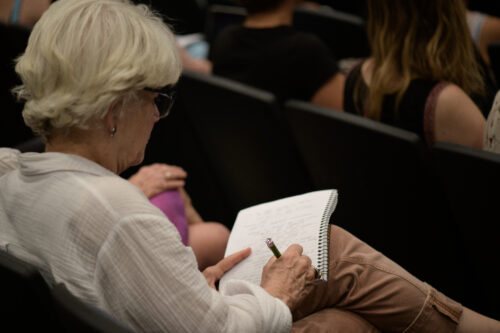Beyond Quotation Marks: How to Write Dynamic Dialogue

Writing dialogue begins with understanding the differences between direct, indirect, and summarized dialogue.
By Cristina Hartmann
June 2nd, 2025
Anyone who has been in an argument knows that it’s not just what you say, it’s how you say it. A quiet “I’m sorry” works better than a screamed apology. It’s not so different in fiction writing.
How we write dialogue can make or break a scene. As fiction writers, we have not just one, but three techniques that we can use to craft powerful, dialogue-filled scenes:
- Direct, indirect, and summarized dialogue are powerful techniques for pacing and characterization.
- Well-crafted dialogue shows, rather than tells, dynamics between characters and reveals character traits.
- Strategic mixing of dialogue technique creates tension and engagement for a dynamic scene.
While this article is focused on fiction, these tools can also be applied to writing dialogue in other forms, like creative nonfiction.
It’s All in the Technique: The Three Types of Dialogue in Fiction
Here is where the nitty-gritty technical details become essential. You might think of dialogue as what comes in between the quote marks, but there are actually three types: direct, indirect, and summarized. Each technique has its own advantages.
Direct dialogue is what we’re most familiar with: a character’s unfiltered words that are usually, but not always, marked by quotation marks. (Without getting into the strange politics of dialogue markers, other styles include the quoteless and the em-dash, but that’s a topic for another day!)
Here’s a simple example of direct dialogue:
“Hey,” he said, snapping his gum.
Here is an indirect version where the narrator paraphrases the dialogue:
He said hey and snapped his gum.
Let’s add more flair to the indirect dialogue by layering the narrator’s perspective:
He hey-ed me, snapping his gum like he didn’t care.
We can do even more with summarized dialogue that condenses entire exchanges:
He hey-ed me, snapping his gum like he didn’t care. I told him to spit that thing out, and we got into it. I won—sort of. He swallowed his Trident while shouting that it was a free country.
These techniques form the foundation of dialogue in fiction. Each technique shapes pacing, characterization, and narrative in different ways. To see these techniques in action, let’s turn to three dialogue maestros: Octavia Butler, Patricia Engel, and Kirstin Valdez Quade.

Great dialogue does more than just tell you what characters are thinking. It will also show you the dynamics at play between characters, even when they don’t speak directly about it.
Octavia Butler: Direct Dialogue for the Win
The first passage comes from Butler’s “Bloodchild,” set in a world where aliens keep humans as hosts for their eggs—with human males like our narrator Gan selected for mandatory pregnancy by his alien captor. (Caution: implied self-harm and guns ahead.)
I lowered the gun from my throat and she leaned forward to take it.
“No,” I told her.
“It’s the law,” she said.
“Leave it for the family. One of them might use it to save my life someday.”
She grasped the rifle barrel, but I wouldn’t let go. I was pulled into a standing position over her.
“Leave it here!” I repeated. “If we’re not your animals, if these are adult things, accept the risk. There is risk, Gatoi, in dealing with a partner.”
It was clearly hard for her to let go of the rifle. A shudder went through her and she made a hissing sound of distress.
…
“I will implant the first egg tonight,” she said as I put the gun away. “Do you hear, Gan?”
— Octavia Butler, “Bloodchild” in Bloodchild and Other Stories
Whew! Wasn’t that tense?
If you were like me, you were holding your breath and taking in each word. A lot goes on here in a complex power negotiation between captor and captive. The dynamic shifts with each line, from Gan’s refusal to surrender his weapon and demand for partnership, to Gatoi’s reluctant concession and final ultimatum. At the end, it’s unclear who has the upper hand.
A single line crystallizes the conflict: “accept the risk … in dealing with a partner.” The risk here, of course, isn’t just the gun or the impending pregnancy. It’s the risk of trusting someone, especially when there’s a power imbalance, a sentiment that reverberates beyond the story’s pages.
Now, imagine this scene in indirect and summarized dialogue:
I lowered the gun from my throat and she leaned forward to take it.
I told her no, and we went back and forth about it before I told her that she needed to accept me as a partner. There was a risk in partnership that she had to accept. She let me have the gun and said the implantation would happen tonight.
Well, at least it’s shorter, right? Except that brevity isn’t what we need here.
Direct dialogue’s expansive effect is precisely what works so well in the original. We slow down and absorb every word. Exactly what we need for this standoff that could define both characters’ futures.
Tips on How to Write Direct Dialogue:
- Layer in the stakes and power dynamics, depending on type of conflict. For a deeper dive, check out this terrific article about four types of conflicts in dialogue from K.M. Weiland.
- Add subtext by mapping out the characters’ thoughts, emotions, physical setting, and actions for each line—without including them directly.
- Revise mercilessly. Great direct dialogue is distilled, layered, and active.
Direct dialogue demands attention. Don’t waste it.
Patricia Engel: The Power of Indirect and Summarized Dialogue
Indirect and summarized dialogue have corresponding strengths, illustrated by a passage from Engel’s “Aguacero” of a chance meeting between two Colombians on a rainy afternoon in New York.
His name was Juan and he was Colombian going several generations back. This much he revealed on that first afternoon. But he’d abandoned Colombia for Europe a decade earlier, and now lived in Madrid with his girlfriend of twenty years and their daughter, who was six. He didn’t ask much beyond my name and my instinct was to tell him a fake one—Sara. But by the end of our coffee, when the rain started to lift, he asked for my number and I gave it. He said we could meet for another coffee sometime. Maybe a walk in a park. We were speaking only Spanish together at this point—I don’t recall at which point we’d made the shift—his with a heavy Bogotá monotone. Without my asking, he admitted he’d recently turned fifty and I responded that I was twenty-five.
“Look at us,” he said, “both partial markers of an incomplete century.”
— Patricia Engel, “Aguacero” in The Faraway World: Stories
Engel compresses an hours-long conversation into two paragraphs, one long and one short. We learn a lot: Juan’s background, the narrator’s fake name, and both characters’ ages. This concise passage also gives us insight into the narrator despite Juan being the ostensible focus.
Filtered through the narrator’s voice, we get the sense that this chance meeting means more than she lets on. The details she remembers. The instinctive shift to their native language. The small truths she reveals. These details stand out more starkly in this compressed format precisely because the narrator chooses the focus.
And, that last line! Juan’s philosophical musings on their ages jump off the page—because of the previous paragraph’s indirect and summarized dialogue. The single line does a lot of work. It signals the relationship’s importance to both characters and shows Juan’s sentimental intellectual side.
Tips on How to Write Indirect and Summarized Dialogue:
- Reveal subtext and character through omissions, missing information, or lies.
- Layer the narrator’s perspective through word choice, internal monologue, and details.
- Turn boring or convoluted exchanges into intense, memorable summaries.
Indirect and summarized dialogue do heavy lifting: compress time, reveal character, and draw attention to direct dialogue. Use them wisely.

There are strengths to each type of dialogue. The key is knowing which to use by understanding what your story needs.
Kirstin Valdez Quade: Mixing Dialogue Techniques for a Dynamic Scene
Let’s get more complicated with this passage from Kirstin Valdez Quade’s “Night at the Fiesta”.
”Fancy-Francy, I ever tell you about the time a lady left a baby on the bus?”
Frances tamped down a surge of irritation, closed her book, and gave her father a tight, tolerant smile in the mirror. “You have.”
…
“Yep,” her father said with enthusiasm. “She gathered up all her packages and boxes, but left the baby.”
He told it again, how another passenger had discovered the baby fast asleep on the seat when they were only a few miles outside of Maxwell, how he’d slowed the bus, made an excruciating many-pointed turn on the empty blacktop highway, and drove back to the depot in town. They found the woman without much trouble; it was a small town, and the man behind the ticket counter pointed her out, sitting on a bench outside the station, surrounded by her luggage.
Frances could understand wanting to abandon a baby; the mystery was why the woman had only left it on a bus and not in the boondocks where no one would find it.
…
“My God,” said the woman. “She must have been out of her head with worry.”
“Claimed it was a mistake and practically tore that baby from my arms. But I’m not sure she convinced me, wasn’t crying or anything. Who’s to say she didn’t pull the same stunt on some other guy’s route?” Still, the story had a happy ending: “All that, and we arrived in Santa Fe only nine minutes behind schedule.”
— Kirstin Valdez Quade, “Night at the Fiesta” in Night at the Fiestas: Stories
Here Quade shifts techniques effortlessly, going from direct dialogue to description to indirect and summarized, then back to direct without breaking a sweat.
(For a fun craft exercise, mark each sentence or paragraph with direct, indirect, summarized, description, internal monologue to discover how each technique maintains the flow and tension.)
The shifts draw us in and keep us engaged. The father’s comments about the abandoned baby story pique our curiosity, and the following description keeps us in suspense. Then we move to indirect dialogue that hints at how often Frances has heard the story multiple times already, and then to a vivid summary of the story. Afterward, we get different reactions: Frances’ unspoken cynicism, the passenger’s shock, and the father’s rationalizations.
The three techniques work together to form a tight, dramatic narrative and a rhythm that emphasize important character dynamics: Frances’ teenage indifference, her father’s earnest, somewhat clumsy attempts to connect with his daughter, the passenger’s genuine interest in the story. The rhythm turns an anecdote about a bus adventure into character portraits and clever foreshadowing.
Tips on How to Mix Dialogue Techniques:
- Use direct dialogue to introduce indirect and summarized dialogue and vice-versa.
- Break up direct dialogue with internal monologue or indirect dialogue that add layers.
- Use different dialogue types to create a rhythm: direct for staccato, powerful beats, and indirect and summarized for softer, undulating notes.
Mixing dialogue techniques creates a scene’s rhythm. Make sure you hit the right beats.
Choosing Your Technique
At this point, you are probably saying: “This sounds great, but how do I choose?”
The best way is to just try them all. You can write out an entire scene in direct dialogue, turn it into indirect, and then summarize it. You can then mix the techniques, keeping a few things in mind:
- Direct dialogue slows down time, and summarized dialogue speeds it up.
- Indirect and summarized dialogue infuses the narrator’s perspective, and direct dialogue gives direct access.
- Direct dialogue draws the reader’s attention while indirect and summarized dialogues create a seamless flow.
There are other considerations, like POV, story length, and style that also influence your choices. But ultimately, dialogue is a versatile tool that goes beyond quotation marks. Each technique creates a different relationship between the reader and the character.
Direct dialogue gives us unfiltered access to characters’ words and demands more attention.
Indirect dialogue infuses spoken words with the narrator’s perspective, giving us insight into both the narrator and the speaker.
Summarized dialogue compresses time and captures subtle relationship dynamics.
How you write dialogue is just as important as what a character says. Armed with these techniques, you can write braver and bolder dialogue. Now, get writing!

Cristina Hartmann
cristinahartmann.comCristina Hartmann is a DeafBlind Brazilian-American writer living in Pittsburgh with her longtime partner and a slobbery cat named Moo-Moo. After transitioning from law, she earned an MFA in Writing from the Vermont College of Fine Arts in 2024, and her work explores relationships and identity through disability and immigrant experiences. Her fiction was shortlisted for the Masters Review Summer 2021 Short Story Award and has appeared in Monkeybicycle, the Stillhouse Press’s anthology In Between Spaces, descant, The MacGuffin, Peatsmoke, and elsewhere.
Related Posts
- A Closer Look at VCFA’s Tuition May 23, 2025
- How to Get Your Art into a Gallery Jun 09, 2025
- 7 Tips for How to Write a Picture Book May 26, 2025

